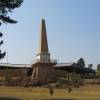Primary tabs
THIS IS THE ARCHIVE FOR SAHRIS 1.0
THIS SITE IS NOW AN ARCHIVE AND IS NOT SUITABLE FOR MAKING APPLICATIONS
Please be aware that no content and application creation or changes to information on this version of SAHRIS will be retained.
To make applications or utilise SAHRIS for the creation of information, please use the new site:
https://sahris.org.za
Changes to SAHRIS!
The South African Heritage Resources Information System (SAHRIS) has undergone a generational upgrade and restructure. These changes to the site include, but are not limited to:
- A new & modernised look and layout
- Improved site usage flows with respect to applications and content creation
- Improved site performance and stability
Launch for the new version of SAHRIS occurred on Monday the 30th of October 2023.
The new site can be found here:
SAHRIS | SAHRIS
9/2/233/0005
- 704 reads
Group
Post date: 07/08/2012
- 1 of 2
- next ›


Archive Import
History: Krugersdorp lies about 32 kilometres west of Johannesburg. Not far from the centre of the town, beside the road to Pretoria, is the Paardekraal monument, one of the most important monuments in South Africa. This monument marks the focal point of the First Transvaal War of Independence and consequently commemorates an event of special importance in the history of the Zuid-Afrikaansche Republiek.
In 1877 Sir Theophilus Shepstone, acting on the instructions of the British Government and against the wishes of t Boer population, proclaimed the independent Zuid Afrikaansche Republiek to be British territory and took over the government. This sudden and arrogant action so dumbfounded the Boers that for a time there was a period of passive resistance under the leadership of a national committee of 32 members. Gradually, however, the opposition took on a more positive form. In December, 1880, the National Committee called a meeting of the people at this site on the farm Paardekraal which had originally belonged to General A. W. J. Pretorius. The meeting took place from 10th to 14th December. At this meeting the Government of the Zuid-Afrikaansche Republiek, as it had existed before the annexation in 1877, was restored. A triumvirate consisting of Paul Kruger, Piet Joubert and M. W. Pretorius was placed at the head of the Government and it was decided simply to occupy a suitable place and to exercise the functions of government from there.
On the last day of the meeting, Tuesday, 14th December, the crowd of 4 000 people spontaneously marked the occasion by building a cairn nearly 3 metres high. One of the Rustenburg burghers, Marthinus Ras, hoisted a Vierkleur tied to a bamboo pole on top of the cairn which had to bear witness to the solemn determination of those present to restore the independence of the Republic. Two days later, on 16th December, 1880, the First War of Independence broke out.
When the independence of the Republic had been restored in 1881 the Volksraad decided to hold a national celebration at Paardekraal on 16th December, 1881, to commemorate both the outbreak of the war, and also the victory over Dingane at Blood River in accordance with the vow taken by the Voortrekkers in 1838. On that occasion more stones were added to the cairn. In December, 1886, another large official celebration was held at the cairn.
In 1887 the town of Krugersdorp was laid out on a portion of the farm Paardekraal to the west and south- west of the historical site. In order to preserve the site with the cairn for future generations, the owner, M. P. W. ( Vaal Martiens) Pretorius, who was a nephew of Gen. A. W. J. Pretorius, donated it to the Government. An additional 428 hectares to the east and south-east of the site was purchased to provide adequate space for celebrations. By this time the site had acquired such a significance that the Government decided in 1889, on the recommendation of the Special Landdrost of Krugersdorp, to build a monument over the cairn in such a manner that ‘the existing pile of stones must remain intact and visible’.
The monument was designed by Sytze Wierda, the Government Architect, and provided a balcony for speakers and four panels for inscriptions. It was built by W. Y. Veitch and completed on 27th November, 1890. President Kruger inaugurated it at the next five- yearly official celebrations after 1886, on 16th December, 1891. The inscriptions, which relate events from the arrival of the Huguenots to 1881, were not yet ready and were added later.
The last celebrations at Paardekraal before the out break of the Anglo-Boer War took place in 1896. During the war, in 1900, the British Government had the stones under the monument removed in railway trucks and dumped into the Vaal River at Vereeniging. In 1912 the monument and the site were preserved as a national monument in terms of a Transvaal ordinance of 1903.
Proclaimed 1936"
Visual Description:
Colours:
Site Features:
Condition:
Construction Date: 27th November, 1890
Materials:
Catalogue: , No: , Significance Category: